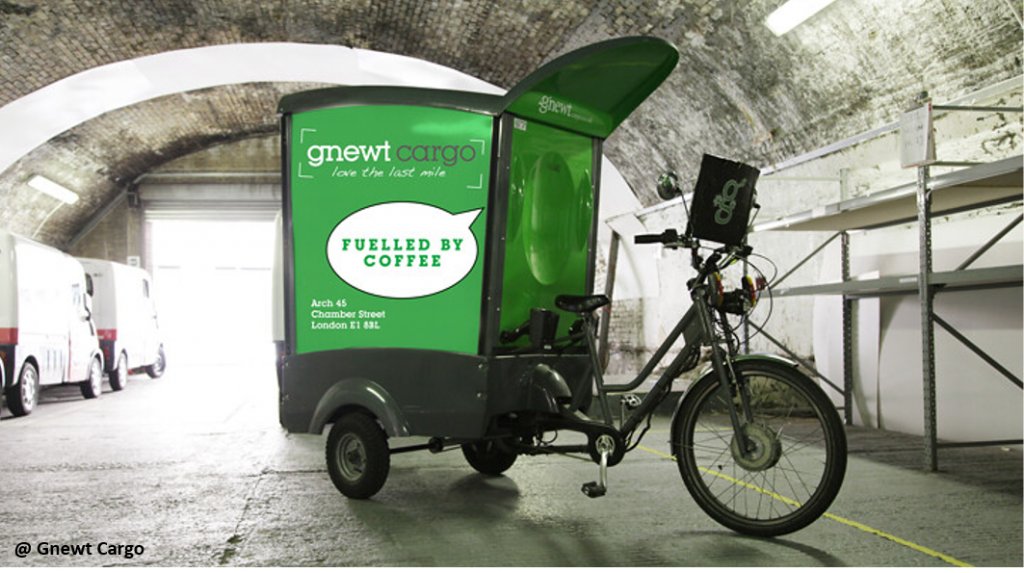
1. Presentation
This measure promotes the use of conventional and cargo bicycles for services and urban logistics, including various strategies such as the support of bicycle delivery networks, subsidies for cargo bike investments, creation of parking spaces specifically for cargo bikes, development of city-logistics concepts for cargo bikes, promotion of marketing programmes for encouraging cargo bikes. Bicycles have more benefits in urban environments when compared to the needs of investment, maintenance, space for parking, licensing, and health and environmental costs of motor vehicles. In addition, bicycles avoid congestion, making them more reliable for deliveries and service provision.
2. Objectives
- Promoting a sustainable form of logistic transport and public services in urban areas (short distances and light/ heavy goods).
- Enhancing the regularization of cargo loading and unloading in urban areas, by exploiting the advantages of cycling in the first and last kilometres of freight transport.
3. Measure’s importance
Freight vehicles in Europe account for 6-18% of urban travel, 19% of energy consumption and 21% of CO2 emissions. Thus, the use of freight bicycles, particularly in urban centres, is a sustainable alternative (0% GHG emissions and other pollutants) to conventional light freight vehicles, with all the subsequent benefits.
1. Best Practices
– Build the necessary infrastructure to enable bicycle mobility (See Cycling Network and Safe and efficient intersections).
– Create cargo bikes parking (See Bike Parking Network).
– Promote the implementation of standards for cargo bicycles in logistics systems, exploiting the relative advantages of delivery and collection done by hybrid vehicles, in particular on the first and last kilometres over other modes of transport.
– Explain the principles behind the measures to make it clear its importance and impacts (See Information).
– Make sure cycling infrastructures exist before discouraging the car use.
– Monitor and reframe measures to meet user needs without compromising sustainable ideals (See Management, Monitoring and Maintenance).
2. Actions
 | Trial programmes Promote bicycle use by creating free trial programmes for businesses and public services, such as offering bicycles for a trial period or creating an initial proposal for a cycling mobility plan. |
 | Financial incentives Offer tax incentives to companies that invest in bicycle fleets. (See Financial incentives to cycling) |
 | Restrictions motorized freight vehicles Strengthen the control of traffic violations of motorized freight vehicles. Limit access for motorized freight vehicles in certain areas. |
 | Increase bicycle use in public services Promote the use of bicycles in public services, such as by the police forces, maintenance services (such as garbage collection), or for the transport of documents. This would contribute to the affirmation of bicycles as a fully integrated and legitimate means of transport, and would improve the ability to intervene and monitor non-compliance with road legislation. |
 | Branding (See Branding) |
1. Impacts
 | Mobility system efficiency Modal shift to cycling (bicycles and cargo bicycles) in urban areas will contribute to reduce congestion as well as to reduce delivery times and infrastructure costs, contributing to a more efficient mobility system. |
 | Livable streets Motor vehicle replacement will contribute to reduce congestion, improving air quality, reducing noise pollution, and improving street life. |
 | Protection of the environment Cycling is one of the most sustainable modes of transport, so shifting from motorized modes to cycling will lead to environmental gains, both in GHG reduction, air pollution (NOx, PM), noise pollution, and resource and energy consumption. |
 | Inclusion, equity and accessibility Due to the significantly lower costs of buying a cargo bike compared to a conventional freight vehicle, this may represent a job opportunity for low-income people. |
 | Safety and comfort “Safety in numbers” effect, i.e. studies show that the increase in the number of cyclists tends to reduce the number of accidents per km. However, especially for higher capacity bicycles, a high physical effort by the rider is required (which can be minimized with the use of electric bicycles). |
 | Economic value The acquisition and maintenance cost of a bicycle is much lower than of a conventional commercial vehicle (although with a large number of cargo bikes, closed parking is required to prevent theft), with additional gains of reduced congestion as well as reduced delivery times and infrastructure costs. |
 | Awareness and acceptability By promoting the use of bicycles as a method of transporting goods while increasing the levels of bicycles in the city, this measure promotes bicycles and contributes to the standardization of bicycles as a sustainable urban transport mode. |
Legend:
| Very positive | Positive | Neutral | Negative | Very negative |
2. Barriers
 | Legal Varies according to the legislation of each country. Operators wishing to use cargo bicycles should pay particular attention to: restrictions on access to motor vehicles; restrictions on bicycle use; GHG emission reduction directives/laws as they increase or decrease the viability of using cargo bikes. |
 | Finance Acquisition and maintenance costs vary by model, but are always lower than conventional goods vehicles. |
 | Governance It may involve public authorities (grants, restrictions) and companies, cycling organizations and other interest groups. |
 | Political acceptability Current opinion is that cargo bikes have capacity limitations associated with standard saddlebags, and therefore their potential for reducing motor vehicles in city centres is often disregarded as political priorities. |
 | Public acceptability Current opinion is that cargo bikes have capacity limitations associated with standard saddlebags, and therefore potential customers of this service tend to disregard this option, making economic viability difficult. |
 | Technical feasibility The technical requirements are not complex. |
Legend:
| No barrier | Minimum barrier | Moderate barrier | Significant barrier |
3. Budget
| Area | Measure | Unit | Cost | Implementation year |
| Porto, Porto Metropolitan Area (Portugal) | Acquisition of eight bicycles for the Municipal Police velocipede team. | 8 bicycles | 8 019,20 € | 2017 |
Case Study 1: Gnewt Cargo (London, United Kingdom)


Gnewt Cargo is a logistics company, founded in 2009, which aims to reduce air pollution and congestion while being competitive. With an initial fleet of 1 electric vehicle and 8 cargo bikes, the company has grown steadily now with over 100 electric vehicles. Due to limited motorized access to central London, major logistics companies subcontract Gnewt Cargo to deliver last mile deliveries because of the ease of access by their cargo bikes and electric vehicles.
Impact:
 | Mobility system efficiency The use of cargo bikes and electric vehicles is a competitive advantage in London’s highly conditioned centre. This business model contributes to reduce congestion, delivery times (on-demand distances shortened 14%) and infrastructure costs, contributing to a more efficient mobility system. |
 | Livable streets Decreases air and noise pollution as well as congestion, contributing to a better quality of life. |
 | Protection of the environment It has reduced distances by 14% and CO2eq emissions by 55% on demand, contributing to the reduction of GHG and other air pollutant emissions, noise pollution, as well as the reduction of resource and energy consumption. |
 | Inclusion, equity and accessibility No impacts. |
 | Safety and comfort Increasing the number of cyclists potentially contributes to the “safety in numbers” effect. |
 | Economic value The company has grown substantially (eg in 2014 the company has doubled in size) leading to the acquisition of vehicles and expansion plans for other British cities (Oxford), showing the economic viability of such systems. |
 | Awareness and acceptability The acquisition of new customers and the constant growth of the company, demonstrates the economic viability of this model, setting a good example for other companies to follow, leading to the normalization bicycles as a method for the transportation of goods. |
Case Study 2: Introducing bicycle home delivery in Burgdorf (Switzerland)


The municipality of Burgdorf (Switzerland) introduced in 1997 a bicycle home delivery service. Customers may do their shopping; however, they can leave their purchased goods in the supermarket and these are later delivered to their homes. This service gives the customers the opportunity to walk or cycle without having to worry about carrying heavy goods, avoiding travel by car. The service uses electric bicycles with trailers to make home deliveries.
Impact:
 | Mobility system efficiency Most people use the car to go grocery shopping because the products are often too heavy to carry on foot or on a conventional bicycle. Thus, this service is an alternative to car use, allowing customers to purchase their products without the inconvenience of having to carry heavy loads home, with efficiency gains for the mobility system. |
 | Livable streets By enabling people to shop through active modes (and delivering products by bicycle), this service contributes to the modal shift to active modes, providing opportunities for social interaction and reductions in air and noise pollution as well as congestion. |
 | Protection of the environment An evaluation of the year 2002 showed that 21% of all customers in Burgdorf changed from driving the car to walking and/or cycling. Thus, by promoting a modal shift from the car to active modes and using the bicycle to deliver the goods, this service contributes not only to reduce GHG and other air pollutant emissions, but also to reduce noise pollution as well as resources and energy consumption. |
 | Inclusion, equity and accessibility This service was combined with a welfare programme and most of the employed deliverers are long-term unemployed., that got the chance to re-enter the labour market. In addition, lower income populations tend to have lower car ownership rates, and therefore limited access to essential goods and activities such as grocery shopping. This system allows the population to move through active modes to make the necessary purchases for everyday life. |
 | Safety and comfort Greater safety is expected as a result of increased levels of bicycle use which in other case studies lead to a reduction in the associated risk (safety in numbers effect). |
 | Economic value The number of deliveries of this service has increased exponentially from 4000 deliveries in 1998 to 25000 deliveries in 2010 (in a city of 15000 inhabitants). Due to the success of this service, this model was extended to 12 Swiss cities including Zurich and Geneva, strengthening local trade in the process. |
 | Awareness and acceptability By increasing the levels of bicycle use, the system contributes to the standardization of bicycles as a sustainable mode of transport for people and goods. |
Case Study 3: Cargo bicycles in Copenhagen (Denmark)
Legend:
| Very positive | Positive | Neutral | Negative | Very negative |
Cyclelogistics (2018). CityChanger CargoBike. Available at: http://cyclelogistics.eu/index.php?id=39&folder_id=111
ECLF. European Cycle Logistics Federation. Sootfree for the Climate: Guideline for cargobike. Availableat: http://www.sootfreecities.eu/sootfreecities.eu/public/download/best-practice/cargo-bikes.pdf
Eltis, 2015. Introducing bicycle home delivery in Burgdorf (Switzerland). 2019. Available at: http://www.eltis.org/discover/case-studies/introducing-bicycle-home-delivery-burgdorf-switzerland
IMPIC. Base: Contratos públicos online. Available at: http://www.base.gov.pt/Base/pt
Reiter, K. & Wrighton, S. (2014). Potential to shift goods transport from cars to bicycles in European cities, s.l.: cyclelogistics – moving Europe forward. Accessed 2 July 2019. Available at: http://one.cyclelogistics.eu/docs/111/CycleLogistics_Baseline_Study_external.pdf
Schliwa, G. et al. (2015). Sustainable city logistics — Making cargo cycles viable for urban freight transport. Research in Transportation Business & Management, Volume 15, pp. 50-57.
Learn more: https://radkompetenz.at/en/2338/citychanger-cargobike/
